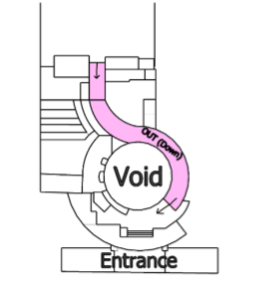Sustainability and friendly circulation path in Sangiran museum, Sragen Indonesia
DOI:
https://doi.org/10.23917/arstech.v2i2.440Keywords:
Accessible, Friendly circulation, Sangiran museum, Sustainability, Circulation pathwayAbstract
Museums are windows into a country's past. Museums can tell stories about history and life. Sangiran museum is one of the world's heritages that tell the story of human evolution from prehistoric times to the present. The presence of historical or other information in the museum heavily relies on the zoning of space and circulation paths. The circulation of visitor movements between spaces and buildings significantly impacts the museum's function. Submission of historical information to visitors will be easier to understand if there is good circulation, which supports visitor movement activities. In the observations, the movement of visitors at the Sangiran museum has constructed an uncomfortable feeling for the users. This study aims to assess the circulation path's compliance with government standards. Due to the nature of this study, a descriptive qualitative approach is required. The study discovered three types of circulation paths that were not user-friendly, namely ram, stairs, and hallways. They did not meet Indonesian government and international data architecture standards. Hence, this study proposes an easy-to-implement design to ensure the long-term function and sustainability of the circulation pathway.
Downloads
References
T. Pynkyawati, S. Aripin, E. Ilyasa and L. Ningsih, and A. Amri, "Kajian efisiensi desain sirkulasi pada fungsi bangunan mall dan hotel BTC", Jurnal Reka Karsa, vol. 2, no. 1, pp. 1-12, 2014. https://doi.org/10.26760/rekakarsa.v2i1.452.
T.I. Naibaho and U.I.M. Hanafiah, "Analisa sirkulasi ruang gerak pengguna pada area baca di perpustakaan universitas swasta", Jurnal IDEALOG, vol. 3, no. 3, pp. 283-296, 2016. https://doi.org/10.25124/idealog.v1i3.979.
B. Hasanah, "Pelayanan aksesibilitas jalan umum (jalur pedestrian) bagi penyandang disabilitas (Studi kasus kota Serang)", Jurnal IJTIMAIYA, vol. 1, no. 1, pp. 61-78, 2017. http://dx.doi.org/10.21043/ji.v1i1.3101.
M. Fachrurrozi and D. Astuti, "Evaluasi ruang gerak sirkulasi koridor pasar klewer terhadap kenyamanan dan keamanan para pengunjung pasca renovasi", in Seminar Ilmiah Arsitektur Tingkat Nasional (SIAR-II), Surakarta, Indonesia, 2020. http://hdl.handle.net/11617/12105.
F. Lase, A. Purnomo, and Nuzuliar, "Penataan efisiensi sirkulasi ruang dalam dan ruang luar untuk disabilitas pasa stasiun MRT Lebak Bulus", Prosiding Seminar Nasional Pakar Universitas Trisakti, 2019. https://doi.org/10.25105/pakar.v0i0.4159.
A. Irsyadi and W. Setiawan, "Perbandingan sirkulasi bangunan dan pencapaian terhadap transportasi umum pada bangunan mixed-use", SINEKTIKA: Jurnal Arsitektur, vol. 15, no. 1, pp. 7-15, 2018. https://doi.org/10.23917/sinektika.v15i1.8990.
T. Penyusun, Peraturan Pemerintah Nomor 66 Tentang Museum, Jakarta, 2015.
F.O.P. Siregar, "Penilaian Terhadap Arsitektur", Media Matrasain, vol. 8, no. 1, pp. 1-9, 2011. https://doi.org/10.35792/matrasain.v8i1.308.
A.A. Ikechukwu, A.O. Folaranmi, A. Philip, O.S. Ayodele, and O.G. Omachoko, "An assessment of ramp designs as barrier-free accesses in public buildings in Abuja, Nigeria", Humanities and Social Science, vol. 3, no. 2, pp. 75-82, 2015. https://doi.org/10.11648/j.hss.20150302.12.
F. Ceschin and I. Gaziulusoy, "Evolution of design for sustainability: Fromproduct design to design for systeminnovations and transitions," Design Studies Elsevier, vol. 47, no. C, pp. 118-163, 2016. https://doi.org/10.1016/j.destud.2016.09.002.
N. Edwards and J. Dulai, "Examining the relationships between walkability and physical activity among older persons: What about stairs?", BMC Public Health, vol. 18 , no. 1, pp. 1-11, 2018. https://doi.org/10.1186/s12889-018-5945-0.
G. Koster, D. Lehmberg and A. Kneidl, "Walking on stairs: Experiment and model", Physical Review E, vol. 100, no. 2, 2019. https://doi.org/10.1103/PhysRevE.100.022310.
N.C. Ataoglu, "New design in circulation areas and museums the case of The Quai Brainly Museum", Uludag University Journal, vol. 21, no. 1, pp. 117-130, 2016. https://doi.org/10.17482/uujfe.44573.
M.I. Andhikaputra, "Timeless tower: a sustainable museum," Undergraduate thesis, Institut Teknologi Sepuluh Nopember, Surabaya, Indonesia 2017. http://repository.its.ac.id/id/eprint/44378.
L. Glaeser, "Architecture of museum", New York: The Museum of Modern Art, 2011.
O. Finaeva, "Factors determining modern museum complexes architecture," IOP Conference Series: Material Science and Engineering, ICCATS 962 (032080), 2020. https://doi.org/10.1088/1757-899X/962/3/032080.
F.D. Ching, Architecture: Form, Space and Order (Third Edition), Canada: John Wiley&Sons, Inc. Hoboken, 2007.
D. Tarsidi, "Aksesibilitas lingkungan fisik bagi penyandang cacat", Universitas Padjadjaran Bandung Indonesia, 2008.
Kementrian PUPR, "Peraturan Pemerintah No. 14/PRT/M/2017 tentang Persyaratan Bangunan Gedung", PUPR Indonesia, 2017.
E. Neufert, "Data Arsitek", Jakarta: Erlangga, 1991.
International Council on Museums, "ISO 18461 - International museum statistics", Paris, Perancis, 2016. https://www.iso.org/standard/62504.html.
D. Maulipaksi, "Mengenal situs manusia purba sangiran", Kementrian Pendidikan dan Kebudayaan, Riset dan Teknologi, Jakarta, Indonesia, 2017. https://kebudayaan.kemdikbud.go.id/
E. Weanind, "Sangiran museum manusia purba, Sragen (Solo) Jawa Tengah", Kissparry, Semarang, Indonesia, 2018. https://kissparry.com/

Downloads
Published
How to Cite
Issue
Section
Categories
License
Copyright (c) 2022 Seruni Inas Hanendya, Nur Rahmawati Syamsiyah

This work is licensed under a Creative Commons Attribution 4.0 International License.










